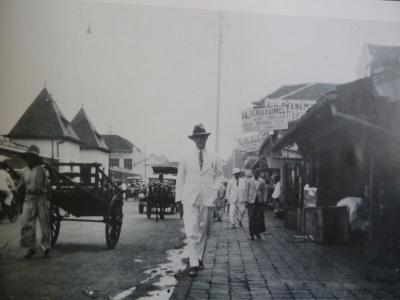Men and hats: The IWI-photographs as a postcolonial Archive
Contained in a small family album, this photograph is part of the Amsterdam Tropenmuseum collection. It was taken in 1929 and shows a white man elegantly dressed in a white suit and hat walking on the Pasar Baroe (new market) in the Chinese area of Bandung, the Netherlands-Indies. Captured in the heart of the image and looking straight into the lens he immediately catches the eye. All our attention is drawn to him as his immaculate white suit, fine hat and nonchalant attitude stand out against the rather dark and messy environment around him. Shops, sign boards, houses, and even the other man with hat on his right side disappear in the background. The captions in the album mention the man’s name, Jaap de Jager, and inform us that he and his wife Bert arrived in the colony in 1929. In the context of the colonial family album this image offers a pleasant dream of home and belonging and involves a record of a white man’s powerful position.
The De Jager couple must have belonged to the so-called “new Europeans” who migrated to the colony after the turn of the nineteenth century when living conditions had modernized and white women were no longer discouraged to embark for the colony. Enjoying a privileged life, “new Europeans” were not in close contact with the local people. The photographs in the De Jager family album give evidence of the contented colonial life of well–to-do white people in comfortable circumstances; chic clothing, a big house surrounded by a lush garden with Indonesian servants, and happy children. Probably, Jaap de Jager was highly positioned in the colonial hierarchy. His portrait mediates a family’s memory of a past life, but as memory interweaves with public history, it also refers to wider narratives and other lives. In fact, the social biography of the De Jager photo changed its course when the family album was brought to the Netherlands and became part of the IWI-collection, which contains more than 60,000 photographs and about 550 albums. These photos were either among the personal belongings of Indies-Dutch postcolonial migrants who “repatriated” after Indonesia’s independence in 1945, or were collected in houses left empty after the war by the Dutch army. As a specific postcolonial archive, the IWI-collection became thus rooted in one of the most contentious parts of national memory - the loss of the beloved and profitable Netherlands-Indies. Yet the IWI-photographs also participated in a postcolonial quest for Indies-Dutch memory and identity.
In the 1950’s Indies spokesman Tjalie Robinson asked Indies migrants to send him stories and personal photographs which he published in his newly founded magazine Tong Tong. This was the beginning of the formation of a new archive as the Indies audience identified with the mediated memories and used the collection to share experiences of a past life. The publication of these photos in Tong Tong and, later, in widely disseminated photo-books changed their status. It relocated and repurposed them from private family contexts to an archival context within the public domain. It is worth noting that it is precisely during the postwar years of national silence and public amnesia about the colonial past, that Indies migrants brought their personal photographs together and, however unsystematically, formed their own archive. Through sharing, using and re-cycling their photographs, the Indies-Dutch made sense of their uprooted lives in a new home and engaged in acts of identity and memory making. In this way, they not merely worked against imposed assimilation, but also shaped a collective Indies-Dutch self awareness and a memory community.
The collected photographs became more institutionalized, and known as the IWI-collection when the Indisch Wetenschappelijk Instituut was founded in 1985. In 2006, due to a state subsidy to compensate for the cold-hearted way in which Indies migrants were received in the Netherlands, the IWI- photographs were documented, digitalized and donated to the Tropenmuseum, a Dutch state-sponsored anthropological institution. The most recent phase of the IWI collection’s biography has begun with its virtual life. In this age of electronic reproduction and dissemination, the status of the collection, including the De Jager photograph, changed again as its memorial power became even more socialized and public. Digitization creates technological data banks of thousands of free-floating images that can be used by anyone. In contemporary media culture the De Jager photograph, which was unique in the context of a family album, may become many images in many different contexts, each open to new interpretations. In an educational environment for instance, the photo of the man with the hat can be used as an example of what everyday pictures can tell us. If we ignore the photographic aesthetics and actively focus on the faceless, anonymous and poorly dressed Indonesian man with the dowdy hat pulling a cart on the left, then the unequal colonial class- and racial relations become visible. This change of perspective would also undermine the double sense of nostalgia invoked by the photo, which primarily goes back to the Tempo doeloe nostalgia (good old colonial times) prevailing in the Netherlands, but also reminds us of smartly dressed men figuring in Hollywood movies from the thirties.
Pamela Pattynama
